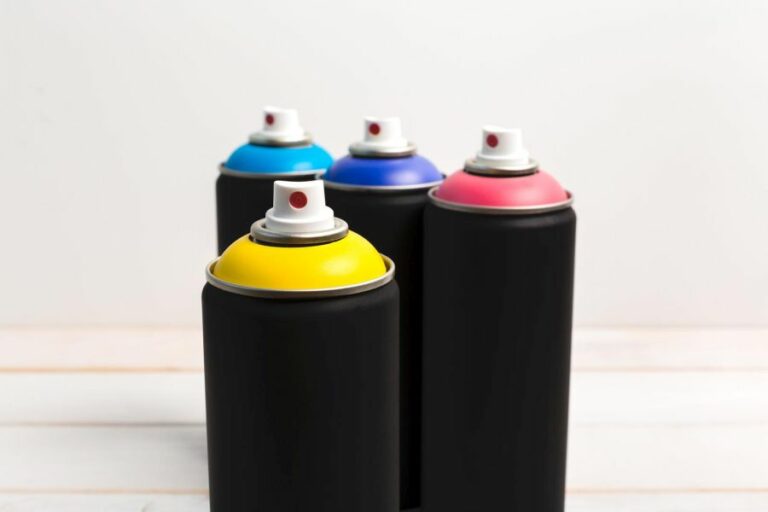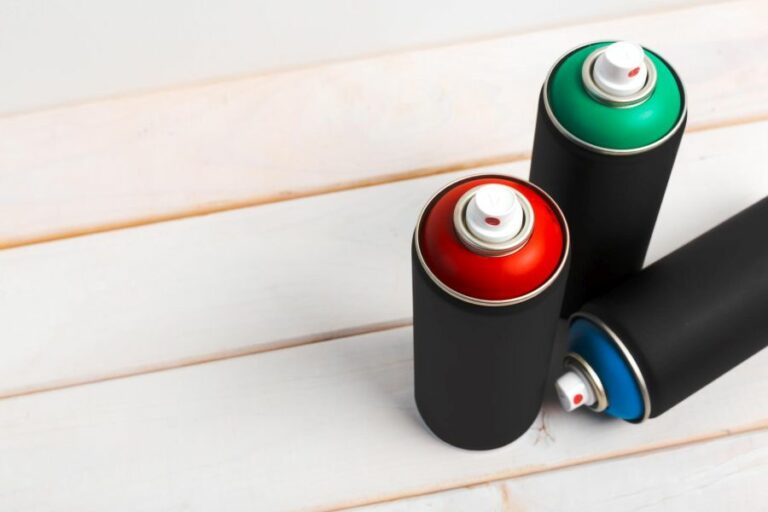How To Properly Clean And Store Spray Paint Cans After Use
Are you tired of dealing with clogged nozzles and poorly functioning spray paint cans after storing them for a while? You’re in luck! I am here to provide simple and effective solutions for properly cleaning and storing your spray paint cans after use. Not only will these tips help you preserve and prolong the life of your cans, but you’ll also achieve the perfect coverage and finish your future projects.
How to properly clean and store spray paint cans after use:
To properly clean and store spray paint cans after use, clear the nozzle by inverting the can and pressing it for a few seconds, then wipe with a cloth. For clogged nozzles, soak in paint thinner or warm soapy water, then scrub gently, rinse, and dry. Store the cans upright in a cool, dry, well-ventilated area with a consistent temperature between 50-80°F. Keep them organized and labeled, and regularly inspect them for leaks, damage, or expiration.

Are you an avid spray paint user? Cleaning and storing your paint cans properly will help extend their shelf life while maintaining their performance. Unlock the secrets to prolonging the life of your spray paint cans. Read on to discover our expert tips and tricks!
Contents
- 1 Effective Cleaning and Storage Techniques for Spray Paint Cans
- 2 Is Upright Storage Necessary for Spray Paint Cans?
- 3 Optimal Storage Methods for Aerosol Cans
- 4 Methods for Cleaning Spray Paint Cans After Use
- 5 Safe Garage Storage Options for Spray Paint Cans
- 6 Ideal Storage Locations for Spray Paint and Paint
- 7 Flammable Cabinet Storage: Does It Apply to All Aerosol Cans?
Effective Cleaning and Storage Techniques for Spray Paint Cans
Spray paint cans are a popular and convenient tool for various DIY projects, art, and automotive applications. However, to ensure their longevity and optimal performance, proper cleaning and storage are essential.
• Cleaning Spray Paint Cans
– Clearing the Nozzle
One of the most critical steps in cleaning a spray paint can is clearing the nozzle. This process not only helps prevent clogging but also makes the can ready for the next use.
- Invert the can: After using the spray paint, turn the can upside down.
- Depress the nozzle: Press the nozzle for a few seconds, allowing the remaining paint and propellants in the nozzle to be released.
- Wipe the nozzle: Use a clean cloth or paper towel to remove any remaining paint residue from the nozzle’s surface.
– Nozzle Maintenance
Sometimes, even after clearing the nozzle, it may still be clogged with dry paint residue. In such situations, the following steps will help remove the clogs.
- Remove the nozzle: Gently grasp the nozzle and pull it away from the can. Be careful not to damage the nozzle’s stem during the process.
- Soak the nozzle: Place the nozzle in a container with paint thinner, rubbing alcohol, or warm soapy water. Allow it to soak for a few hours or overnight.
- Clean the nozzle: After soaking, use a soft brush or toothbrush to gently scrub away any remaining paint residue. Take extra care to clean the nozzle’s orifice and its stem.
- Rinse and dry: Rinse the nozzle thoroughly with clean water, then dry it with a cloth or paper towel before reattaching it to the can.
– Cleaning the Can’s Exterior
Keep the exterior of the spray paint can clean to avoid unnecessary messes and maintain a proper grip when using it.
- Wipe the can: Use a damp cloth or paper towel to remove any paint residue from the can’s surface.
- Remove stubborn stains: If paint stains are difficult to remove, use rubbing alcohol or paint thinner on a cloth to gently rub away the stains.
- Dry the can: Use a clean, dry cloth or paper towel to dry the can thoroughly.
• Storing Spray Paint Cans
– Selecting the Right Storage Space
Proper storage conditions are crucial for maintaining the performance and lifespan of spray paint cans. Consider the following factors when choosing a storage space:
- Temperature: Store spray paint cans in a cool, dry area with a consistent temperature between 50F to 80F. Avoid extreme temperatures, as they can cause the cans to leak, rupture or lose pressure.
- Ventilation: Ensure that the storage area has adequate ventilation to prevent the buildup of dangerous fumes.
- Accessibility: Store the cans in an easily accessible location to avoid unnecessary handling and potential damage.
- Upright position: Always store spray paint cans in an upright position to prevent leaks and the nozzle from being submerged in paint.
– Organizing and Labeling
Keeping your spray paint cans organized and labeled makes it easier to locate specific colors, finishes, or types when needed.
- Group by type or project: Arrange the cans according to their type (e.g., gloss, matte) or intended project for easy access.
- Label the cans: Use a permanent marker or adhesive label to write the color, finish, and any other pertinent information on the can’s exterior.
- Check the expiration date: Keep track of the expiration dates and dispose of any expired or damaged cans accordingly.
– Inspecting the Cans
Regularly inspect your spray paint cans for any leaks, damage or deterioration.
- Check for dents: Examine the cans for any large dents or deformities that could compromise their structural integrity.
- Inspect the nozzle: Make sure the nozzle is securely attached and free of any damage or clogs.
- Monitor the pressure: Shake the cans periodically to ensure they have retained adequate pressure for proper spray coverage.
By following these cleaning and storage practices, you can extend the lifespan of your spray paint cans, ensure their optimal performance, and promote a safe working environment. For additional tips on using and maintaining spray paint, visit EPA’s Spray Painting Tips page.
Step | Description |
|---|---|
1 | Clear the nozzle: Turn the spray paint can upside down and press the nozzle until only clear gas comes out. This will help to prevent clogging. |
2 | Wipe the nozzle: Use a clean cloth or paper towel to gently wipe any remaining paint from the nozzle and cap. |
3 | Store cans properly: Store spray paint cans in a cool, dry place away from sources of heat and flame. Avoid exposing the cans to direct sunlight and extreme temperatures. |
4 | Keep cans upright: Store cans in an upright position to prevent the paint from settling and hardening around the nozzle, which can cause clogging. |
5 | Organize cans: Arrange the cans according to colors and types for easy identification and access. |
6 | Label cans: If necessary, label spray paint cans with their contents and date of purchase to keep track of your inventory and avoid using expired or old paint. |
Is Upright Storage Necessary for Spray Paint Cans?
Whether you are a professional artist or just an occasional spray paint user, proper storage of your spray paint cans is essential to maintain the quality and longevity of the product.
• Improved Product Functionality
Spray paint cans contain a mixture of paint, propellant, and a small agitator ball (usually made of metal or glass). To ensure efficient mixing and even distribution of paint, it is essential to store the cans upright.
– Prevention of Clogging
When you store a spray paint can upright, you ensure that the paint stays at the bottom of the can, away from the spray nozzle. If you store the can on its side or upside-down, the paint may accumulate around the nozzle and cause clogging.
Clogged nozzles can lead to poor coverage, uneven application, and even complete malfunction of the can, rendering it unusable. By simply storing the cans upright, you can avoid this issue and make the most of your spray paint investment.
– Proper Mixing
The agitator ball inside the can is designed to help mix the paint and propellant every time you shake the can before use. Storing the cans upright allows the ball to rest at the bottom of the can (near the paint) when not in use.
This position ensures thorough mixing when you shake the can, leading to more consistent color, texture, and coverage.
• Safety Considerations
Storing spray paint cans upright also helps ensure a safer working environment.
– Reduced Risk of Leakage
If a can is stored sideways or upside-down, the pressure inside the can may cause the paint or propellant to leak out through the nozzle. Leaked propellants are flammable, and exposure to them may pose a risk of fire or explosion.
By storing the cans upright, you minimize the risk of leakage and avoid potential safety hazards.
– Easier Visual Inspection
It’s essential to regularly inspect your spray paint cans for damage, such as bulging or rusting. These issues may indicate an increased risk of the can leaking or bursting.
Storing the cans upright makes it easier to check for these problems and take appropriate action if needed (such as properly disposing of damaged cans).
• Practical Storage Tips
Now that you know why it’s essential to store spray paint cans upright, here are some practical tips for doing so in various environments:
– Shelving Solutions
Consider investing in shelves specifically designed to store spray paint cans, which can hold each can individually in an upright position. These can be found at hardware stores or online and are an excellent solution for organizing multiple cans.
– Secure Containers
If you’re storing cans in a garage, shed, or another area with potential for movement (such as in a vehicle), opt for a secure container that can hold cans upright and in place, such as a milk crate or a plastic storage bin with dividers.
– Climate Control
To prolong the shelf life and performance of your spray paint, store it in a cool, dry area with a consistent temperature between 50-80°F (10-27°C). Avoid extreme temperatures or high humidity, which can negatively impact the quality of the paint.
– Keep Away from Children and Pets
For safety purposes, always store your spray paint cans out of reach of children and pets, as they may pose a choking hazard or risk of puncturing the can.
In conclusion, storing your spray paint cans upright is crucial for maintaining their functionality, ensuring safety, and prolonging the life of the product. By following these tips and recommendations, you can make the most of your spray paint investments and enjoy a safer, more efficient painting experience.
Optimal Storage Methods for Aerosol Cans
Proper storage of aerosol cans is crucial for ensuring their longevity, performance, and safety.
• Understanding Aerosol Cans
Aerosol cans are pressurized containers that store and dispense various products like paint, deodorant, insecticides, and lubricants. They consist of a blend of specific chemicals, propellants, and solvents, which are sensitive to temperature, sunlight, and other external factors.
The US Environmental Protection Agency (EPA) regulates aerosol containers and provides guidelines on their proper use and disposal. Proper storage of aerosol cans reduces risks associated with their content and pressure, ensuring safety and preventing damage to the environment.
• Temperature Control for Aerosol Cans
– Store in a Cool, Dry Place
It is essential to store aerosol cans in a cool, dry, and well-ventilated space. High temperatures can increase the internal pressure of the can, causing it to rupture and explode. I recommend storing aerosol cans at a temperature range between 50-70°F (10-21°C).
– Protect from Extreme Temperature Fluctuations
Exposing aerosol cans to extremely cold temperatures can cause the contents to freeze and lose their effectiveness. On the other hand, exposure to high temperatures can cause the cans to burst or leak.
To avoid such situations, keep aerosol cans away from direct sunlight, heat sources, or areas prone to significant temperature fluctuations like garages, sheds, or attics.
• Safe Storage Practices for Aerosol Cans
– Store Upright
Always store aerosol cans in an upright position with the nozzle pointed upwards. Storing cans upside down or on their sides can cause leakage or malfunction of the nozzle.
– Keep Away from Open Flames and Ignition Sources
Aerosol cans can explode or catch fire if exposed to an open flame or ignition source, such as lighters, candles, or heaters. Store them in a secure location away from these potential hazards.
– Avoid Stacking Aerosol Cans
Never stack aerosol cans on top of each other, as this can result in punctures or damage to the can, leading to leaks or even explosions. Store them on a single row on a sturdy, level surface.
– Label the Cans
Ensure that aerosol cans are clearly labeled with their contents and expiration dates to avoid confusion and help manage inventory. This practice also ensures that you use the cans within their shelf life, maintaining the effectiveness and safety of the product.
• Proper Disposal of Aerosol Cans
When an aerosol can is empty or has reached its expiration date, it should be disposed of properly to avoid environmental harm and comply with local waste disposal regulations.
– Do Not Puncture or Crush Cans
Puncturing or crushing empty aerosol cans can release residual chemicals, propellants, or solvents, which can be harmful to the environment and pose a risk of explosion.
– Check Local Waste Disposal Guidelines
Empty aerosol cans may be recyclable, depending on the local waste disposal regulations. Check with your local waste management authority on proper disposal procedures for aerosol cans.
– Hazardous Waste Collection Programs
In some regions, aerosol cans may be considered hazardous waste, which requires proper handling and disposal. I recommend participating in the local hazardous waste collection programs to ensure the safe and responsible disposal of aerosol cans.
• Conclusion
By following the best practices for storing aerosol cans outlined in this article, you will help maintain the effectiveness and safety of the products while minimizing environmental risks. To summarize:
- Store aerosol cans in a cool, dry, and well-ventilated location within a temperature range of 50-70°F (10-21°C).
- Keep them away from direct sunlight, heat sources, and extreme temperature fluctuations.
- Store them upright with the nozzle pointed upwards, and avoid stacking the cans.
- Keep them away from open flames and ignition sources.
- Label cans with content information and expiration dates.
- Dispose of empty or expired aerosol cans in accordance with local waste disposal regulations.
For further information on aerosol can storage and handling, consult the US EPA website r your local waste management authority.
Storage Tips | Description |
|---|---|
Keep away from direct sunlight | Aerosol cans can heat up quickly and explode if exposed to direct sunlight; look for a cool and dry place for storage. |
Store at room temperature | Avoid extreme temperature changes by storing aerosol cans in areas with consistent room temperature. |
Store upright | Always store aerosol cans in an upright position to prevent leakage and ensure proper functioning. |
Proper ventilation | Choose a well-ventilated area to store aerosol cans to avoid fume build-up. |
Avoid open flames or ignition sources | Keep aerosol cans away from open flames, heaters, or any other sources of ignition to prevent explosions. |
Methods for Cleaning Spray Paint Cans After Use
Cleaning spray paint cans can be a real pain, but it is essential to maintain their functionality and prolong their lifespan.
• The Importance of Cleaning Spray Paint Cans
Spray paint cans can become clogged, leading to uneven paint distribution, spattering, and a general decline in performance. By regularly cleaning your spray paint cans, you can ensure smooth, even application and extend the life of your cans.
• Steps to Clean Spray Paint Cans
1. Safety First
Before you begin cleaning your spray paint cans, it is essential to don the appropriate safety gear. Make sure to wear gloves and safety goggles, as well as a respiratory mask if you are in an enclosed space.
Always perform this task in a well-ventilated area to avoid inhaling toxic fumes. Remember to consult the manufacturer’s instructions on the can for further safety guidelines.
2. Turn the Can Upside Down
To begin the cleaning process, invert the spray paint can, and hold it upside down. This allows the paint to leak back into the can, which can help unclog the nozzle.
3. Clear the Nozzle
With the can upside down, press the nozzle as if you were spraying paint. This will help loosen any clogs and allow the paint to flow back into the can. Do this for a few seconds to clear the nozzle thoroughly.
4. Soak the Nozzle in Solvent
If the nozzle remains clogged, remove it from the can and soak it in a compatible paint solvent, like acetone or mineral spirits. Consult the manufacturer’s instructions on the can for specific solvent recommendations. Allow the nozzle to soak for a few minutes to loosen any dried paint.
5. Clean the Nozzle with a Brush
After soaking the nozzle in the solvent, use a small brush, such as a toothbrush, to gently scrub away any remaining paint residue. Make sure to clean the tiny hole where the paint exits, and be careful not to damage the nozzle during this process.
6. Reassemble and Test
Once the nozzle is clean, attach it back to the spray paint can. Turn the can right side up and test the spray function. The paint should flow smoothly and evenly. If it does not, repeat the previous steps to ensure the nozzle is clean.
• Additional Cleaning Tips and Recommendations
- When storing your spray paint cans, keep them in an upright position to prevent paint from collecting in the nozzle.
- After each use, clear the nozzle by turning the can upside down and spraying until only air comes out. This practice helps prevent the nozzle from becoming clogged between uses.
- In case of a severely clogged nozzle, consider purchasing a replacement nozzle compatible with your specific spray paint can.
- Always clean and dispose of used solvents and materials according to local regulations to protect the environment and maintain safety.
• Conclusion
Regularly cleaning your spray paint cans is crucial for ensuring optimal performance and extending their lifespan. By following the steps outlined in this article, you can effectively and safely clean your spray paint cans and enjoy smooth, even application.
Remember to wear the proper safety equipment, follow the manufacturer’s instructions for your specific spray paint can, and dispose of any waste responsibly.
Step | Description |
|---|---|
1 | Release any remaining pressure by pressing the nozzle. |
2 | Remove the spray nozzle by pulling it straight up. |
3 | Soak the nozzle in a container filled with paint thinner or acetone for 30-60 minutes. |
4 | Use a small brush or old toothbrush to gently scrub the nozzle, removing any dried paint. |
5 | Rinse the nozzle in clean paint thinner or acetone to remove any remaining residue. |
6 | Dry the nozzle thoroughly with a paper towel or cloth. |
7 | Reattach the nozzle to the spray paint can. |
Safe Garage Storage Options for Spray Paint Cans
Storing spray paint cans in a garage is a common practice for many homeowners and DIY enthusiasts. However, it’s essential to understand the safety measures and potential risks associated with it.
• Safety Considerations for Storing Spray Paint Cans
Spray paint cans contain flammable and hazardous materials that can pose a risk if not stored properly. The following are important safety considerations to keep in mind:
1. Temperature Control
Spray paint cans should be stored in a cool and dry environment. The ideal temperature for storage is between 60-80°F (15-25°C). Exposure to extreme temperatures, such as freezing cold or excessively hot weather, can cause the cans to rupture, leading to dangerous leaks or even explosions.
In fact, storing spray paint cans in direct sunlight or near a heat source is highly discouraged. If your garage is prone to heat fluctuations, consider insulating it or storing your spray paint cans in an alternative location.
2. Ventilation
Proper ventilation is essential when storing spray paint cans in a garage. Fumes from the cans can build up over time, posing a health risk if inhaled. An adequately ventilated space can help prevent the risk of fume build-up and potential fires.
3. Secure Storage
When storing spray paint cans in a garage, it’s crucial to keep them away from children and pets. Consider using a locked cabinet or a dedicated storage space that only authorized individuals can access. This will help prevent accidents or potential misuse of the cans.
4. Organized Storage
Organizing your spray paint cans by color, brand, or type will not only help you find the right paint when you need it but also prevent the accidental mixing of incompatible paints.
Keep your storage area neat and clutter-free to minimize the risk of accidents, such as knocking over or damaging cans.
5. Fire Safety
As previously mentioned, spray paint cans contain flammable materials. Ensure that your garage is equipped with a working fire extinguisher, smoke detector, and carbon monoxide alarm.
Moreover, familiarize yourself with the proper use of a fire extinguisher and regularly check the batteries for your smoke detector and carbon monoxide alarm.
• Expert Recommendations for Storing Spray Paint Cans in a Garage
Having covered the essential safety considerations, let’s look at some expert recommendations to help you store your spray paint cans effectively.
1. Use Shelf Dividers
Shelf dividers can help you organize your cans efficiently and prevent them from falling or getting damaged. Additionally, they can make it easier for you to locate specific paint colors quickly.
2. Label Your Cans
Clear labels make it easier to identify the contents of each can. Label each can with its color, brand, and type of paint. Moreover, you may consider adding a small color swatch on the label for faster identification.
3. Store Cans with the Nozzles Facing Out
Positioning the cans so that the nozzles face outward not only makes the labels more visible but also prevents accidental discharge of the paint. This arrangement can minimize the risk of paint leakage, spills, and damage.
4. Practice First-In, First-Out (FIFO) Storage Method
Always use the oldest cans of paint first to ensure that they don’t expire or become unusable. This approach can help you minimize waste and extend the life of your spray paint inventory.
5. Dispose of Empty or Expired Cans Properly
Never throw away empty or expired spray paint cans in the regular trash or recycling bins, as they may still contain hazardous materials.
Contact your local waste management facility to inquire about proper disposal procedures or visit the EPA’s website for more information on handling household hazardous waste.
• Conclusion
Yes, spray paint cans can be stored in a garage, provided that you adhere to essential safety measures and proper storage practices. Temperature control, ventilation, secure and organized storage, and fire safety precautions are crucial factors to consider.
Additionally, implementing expert recommendations, such as using shelf dividers, labeling your cans, and practicing the FIFO storage method, will ensure you store your spray paint cans effectively and securely.
Ideal Storage Locations for Spray Paint and Paint
Storing spray paint and paint cans correctly is essential to ensure their longevity and maintain the quality of the paint inside.
• Ideal Conditions for Storing Spray Paint and Paint Cans
Spray paint and paint cans should always be stored in a cool, dry, and well-ventilated environment. This is due to the fact that extreme temperatures, moisture, and poor ventilation can negatively impact the quality and efficacy of the paint. Some factors to consider when selecting a storage location are:
– Temperature
It is crucial to store paint in an area where the temperature remains consistent and does not exceed 120°F (49°C) or fall below freezing (32°F or 0°C). This is because extreme temperatures can cause the paint to freeze, thicken or separate, thus making it unusable.
During winter months, consider storing paint in a basement, insulated garage, or a temperature-controlled storage unit. In the summer, avoid areas with direct sunlight, such as an attic or non-insulated garage.
– Humidity
High levels of humidity can also damage paint by causing the paint to mold or the metal cans to rust. To protect the paint from humidity, store it in a dry, cool area with a dehumidifier if necessary.
– Ventilation
Proper ventilation is essential to avoid the build-up of harmful fumes from the stored paint. Choose a well-ventilated area with plenty of air circulation, such as a storage shed or a designated paint storage room.
• Safe Paint Storage Practices
Taking proper precautions when storing spray paint and paint cans is necessary for ensuring the safety of both the individuals handling the paint and the environment.
Implementing safe storage practices can mitigate potential hazards and prolong the lifespan of the paint. Some best practices for safe paint storage include:
– Proper Sealing of Containers
Always ensure that spray paint cans and paint cans are tightly closed and sealed to prevent paint from leaking, drying out, or being exposed to oxygen. To seal containers effectively:
- For spray paint, make sure the nozzle is properly aligned and locked in place.
- For paint cans, clean any excess paint from the rim, position the lid correctly, and gently tap it with a rubber mallet or block of wood to create an airtight seal.
– Storing Cans Off the Ground
Store paint cans on a sturdy shelf or pallet, at least several inches off the ground, to prevent moisture, pests, or potential water damage from affecting the paint. This will also help with air circulation around the containers.
– Organizing and Labeling Paint
To facilitate easy access and proper paint management, consider organizing paint by color, type, or project, and clearly label each can with the following details:
- Color name or code
- Date of purchase
- Location or purpose of use
• Disposing of Old or Unusable Paint
Inspect stored paint periodically for usability and responsibly dispose of any old or unusable paint. If the paint has separated, contains mold, or has a foul smell, it may be unsafe for use and must be disposed of correctly.
Consult your local waste management guidelines for guidelines on paint disposal in your area.
• Conclusion
In conclusion, proper storage of spray paint and paint cans is crucial to ensure their longevity, maintain their quality, and promote safety.
By choosing an ideal storage location with consistent temperature, low humidity, and proper ventilation, alongside implementing safe storage practices, you can optimize the performance of your paint products and minimize waste in the long run.
Item | Storage Location |
|---|---|
Spray paint | In a cool, dry place away from heat sources, direct sunlight, and open flames |
Paint | In a cool, dry place with a tight-fitting lid to prevent air exposure |
Flammable Cabinet Storage: Does It Apply to All Aerosol Cans?
Aerosol cans are common in various workplaces and households. They contain a wide range of products like paints, deodorants, insect repellents, and more. However, there is debate over whether it is necessary to store all aerosol cans in a flammable cabinet.
• Understanding the Flammability of Aerosols
Many aerosol cans contain flammable materials, which can be a hazard if not stored and managed correctly.
Flammability is primarily due to the propellants used, as well as the product being sprayed. The most common propellants are hydrocarbons like propane, butane, and isobutane.
Aerosols are classified by their flammability, as specified by NFPA 30B, the Code for the Manufacture and Storage of Aerosol Products:
- Class I (flammable): Contains at least 10% of one or more flammable propellants or substances that exhibit a
flash point < 100F. These aerosols pose the most significant fire hazard. - Class II (nonflammable): Contains substances that exhibit a flash point between
100F and 199F. They do not contain any purposely added flammable propellants. - Class III (nonflammable): Contains substances with a flash point greater than or equal to
200Fand have no added flammable propellants.
• Do All Aerosol Cans Require a Flammable Cabinet?
Given the varying flammability of aerosols, storing them in flammable cabinets depends on the specific aerosol and its contents. A flammable cabinet is recommended for:
- Class I aerosols, which possess a higher risk of igniting and risk spreading fire.
- Locations. Storing a large quantity of mixed aerosols, regardless of their class or flammability, as a precautionary measure against potential hazards resulting from the mixture.
For Class II and Class III aerosols with lower fire risk, a flammable cabinet may not be strictly necessary. However, exercise caution when storing these cans and ensure they are not subjected to extreme temperatures, heat sources, or open flames.
• Guidelines for Proper Aerosol Can Storage
It is crucial to follow specific guidelines when storing aerosol cans to maintain workplace and household safety. Some prominent recommendations include:
– Choosing the Right Storage Cabinet
When deciding to use a flammable cabinet, it should meet appropriate regulatory standards, such as OSHA 1926.152 and NFPA 30. A compliant cabinet will have features like self-closing doors, adequate ventilation, and proper labeling for quick identification.
– Managing Quantity and Segregation
Limiting the number of aerosol cans stored in a single location can help reduce potential hazards. Additionally, segregating incompatible or reactive aerosol products prevents the risk of adverse chemical reactions, which can lead to fires or explosions.
– Inspecting and Maintaining
Regularly inspect stored aerosol cans for leaks, dents, or damages. Dispose of damaged cans properly to minimize the risk of accidental ignition. Additionally, ensure the storage cabinet is well-maintained, clean, and free from debris, which can act as a fire hazard.
– Educating and Training
Proper education and training on handling and storing aerosol products are essential. Ensure that employees and users understand and adhere to the guidelines, policies, and safe practices concerning aerosol can storage.
• Personal Experience and Recommendations
From my experience, it is best to err on the side of caution when storing aerosol cans. Store all aerosol cans, including Class II and Class III, in a flammable cabinet if feasible. Doing so:
- Enhances workplace and household safety
- Allows for quick response during emergencies
- Ensures compliance with regulatory standards
Moreover, pair the storage measures with appropriate training and education for all individuals who handle or use aerosol cans. This combination will significantly decrease the risk of accidents and fires related to the aerosol can storage.
To summarize, not all aerosol cans require storage in a flammable cabinet. However, taking extra precautions is wise to ensure maximum safety when dealing with these products. Adhere to all guidelines and regulations, and always prioritize safely handling and storing aerosol cans.







